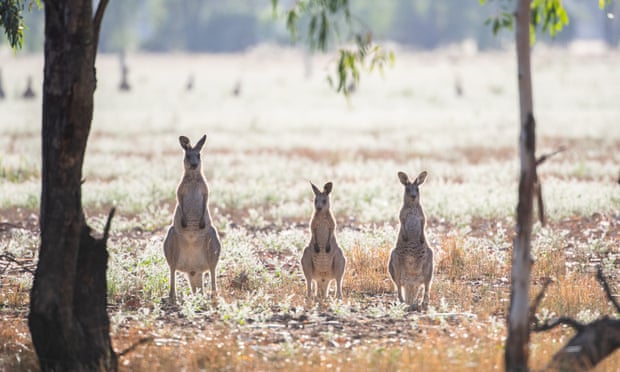Tense competition is brewing between the greater glider and the koala in Australia’s marsupial of the year vote but there are hopes a silky tailed species that “mates themselves to death” could win over voters and maybe even save it from heading towards extinction.
Network Ten’s The Project launched the competition in collaboration with organisations and charities that work with or help preserve the habitat of marsupials, many of them endangered, in a bid to raise funds for them.
There are 21 species battling it out and, as of Monday, the endangered greater glider was at the top of the leaderboard, with the koala, the northern hairy-nosed wombat, the quokka and the numbat in close pursuit.

But Rachel Lowry, the chief executive of Bush Heritage Australia, believes the brush-tailed phascogales will prove to be the dark horse of the competition. Lowry is confident the species’ many “quirks” will win people over, along with its fashionable tuft of silky black hair on its tail.
“Not a lot of people realise this is a species where the males literally mate themselves to death,” Lowry said.
“Once they start to discover the joys of copulation, they just keep mating. They forget to eat and then they drain their energy and they die.”

Lowry has been campaigning on Bush Heritage Australia’s social media pages to get the brush-tailed phascogale into the top 10 and raise money to support its conservation.
“They’ve lost over half their home range due to habitat loss,” Lowry said. “We are not sure what kind of a chance they’re going to have unless we raise their profile.
“If they make it into the top 10 … it means we get to keep connecting landscapes and regenerating native corridors and protecting tree hollows, which is what these little guys need if they’re going to stand a chance.”
Almost every marsupial in the running is in need of support – the competition’s website classifies each species from “Doing OK” to “In some trouble” and “In serious trouble”. Only three – the Tasmanian pademelon, marsupial mole and the long-tailed planigale – are categorised as “Doing OK”.

But the gerbil-like northern bettong is “right on the brink of extinction”, Joey Clarke from Australian Wildlife Conservancy warns.
Clarke said northern bettongs, which look like miniature wallabies hopping around the forest, once had four populations but 20 years ago two of those were “blinked out”.
“Today the remaining population in the world are on two sites,” he said. “One of those populations is down to between 10 and 30 individuals, so it is literally right on the edge of disappearing. The other has a few hundred.”

The northern bettong has a preference for open eucalypt forest on the edge of rainforests – a niche habitat and one that has declined because of land clearing.
“Without intervention, this is a species that could very easily disappear, not just within our lifetimes, but within the next couple of decades,” Clarke said.
After a two-week public vote, the marsupial of the year top 10 will be announced and fundraising campaigns will be launched for each. The winner will be announced on Monday 30 September.
The Project’s executive producer, Chris Bendall, says the aim is to raise as much money as possible for conservation organisations, saying they are “amazing people doing amazing work to help save these animals, but they need the funds to do it”.
Bendall hopes voters “consider some of the lesser known and more endangered animals when they cast their vote”.
“We would love this competition to make people more curious about our native marsupials because they are unlike anywhere else in the world,” he said.
“If at the end of all this people are just that little bit prouder and more informed about our natural heritage, that can only be a good thing.”
This article by Rafqa Touma was first published by The Guardian on 10 September 2024. Lead Image: A koala joey at Sydney Zoo. The koala is among the 21 species vying for The Project’s marsupial of the year vote. Photograph: Bianca de Marchi/AAP.
What you can do
Help to save wildlife by donating as little as $1 – It only takes a minute.







Leave a Reply